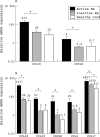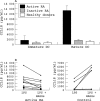Increased expression of CCL18, CCL19, and CCL17 by dendritic cells from patients with rheumatoid arthritis, and regulation by Fc gamma receptors
- PMID: 15331393
- PMCID: PMC1755402
- DOI: 10.1136/ard.2003.017566
Increased expression of CCL18, CCL19, and CCL17 by dendritic cells from patients with rheumatoid arthritis, and regulation by Fc gamma receptors
Abstract
Background: Dendritic cells (DC) have a role in the regulation of immunity and tolerance, attracting inflammatory cells by the production of various chemokines (CK). Fc gamma receptors (Fc gamma R) may be involved in regulation of the DC function.
Objective: To assess the expression of CK by immature (iDC) and mature DC (mDC) and its regulation by Fc gamma R in patients with RA and healthy donors (HC).
Methods: Expression of CK by DC from patients with RA and from HC was determined by real time quantitative PCR and ELISA. DC were derived from monocytes following standardised protocols. To study the potential regulation by Fc gamma R, iDC were stimulated with immune complexes (IC) during lipopolysaccharide (LPS) induced maturation. The presence of CK was studied in synovial tissue from patients with RA, osteoarthritis, and healthy subjects by RT-PCR and immunohistochemistry.
Results: iDC from patients with RA had markedly increased mRNA levels of the CK CCL18 and CXCL8. Upon maturation with LPS, expression of CCL18, CCL19, CXCL8, CCL3, and CCL17 increased dramatically, reaching significantly higher levels in patients with RA. Monocytes failed to express these CK, except for CXCL8 and CCL3. IC-mediated triggering of the Fc gamma R on DC from patients with highly active RA down regulated all CK, whereas the reverse was seen when DC from patients with low disease activity and healthy donors were stimulated. CCL18 was significantly increased in RA synovial tissue.
Conclusion: Increased CK expression by DC was found in patients with RA. This expression is partly regulated by Fc gamma R triggering and results in an inhibitory DC subtype in RA upon Fc gamma R-mediated triggering.
Figures







Similar articles
-
Increased FcgammaRII expression and aberrant tumour necrosis factor alpha production by mature dendritic cells from patients with active rheumatoid arthritis.Ann Rheum Dis. 2004 Dec;63(12):1556-63. doi: 10.1136/ard.2003.016550. Ann Rheum Dis. 2004. PMID: 15547078 Free PMC article.
-
Dendritic cells from patients with rheumatoid arthritis lack the interleukin 13 mediated increase of Fc gamma RII expression, which has clear functional consequences.Ann Rheum Dis. 2005 Dec;64(12):1737-43. doi: 10.1136/ard.2004.034405. Epub 2005 May 5. Ann Rheum Dis. 2005. PMID: 15878907 Free PMC article.
-
High production of proinflammatory and Th1 cytokines by dendritic cells from patients with rheumatoid arthritis, and down regulation upon FcgammaR triggering.Ann Rheum Dis. 2004 Jun;63(6):696-702. doi: 10.1136/ard.2003.010033. Ann Rheum Dis. 2004. PMID: 15140777 Free PMC article.
-
Fc gamma receptor mediated modulation of dendritic cells as a potential strategy in the battle against rheumatoid arthritis.Neth J Med. 2006 Apr;64(4):103-8. Neth J Med. 2006. PMID: 16609156 Review.
-
Arthritic and non-arthritic synovial fluids modulate IL10 and IL1RA gene expression in differentially activated primary human monocytes.Osteoarthritis Cartilage. 2015 Nov;23(11):1853-7. doi: 10.1016/j.joca.2015.06.003. Osteoarthritis Cartilage. 2015. PMID: 26521731 Review.
Cited by
-
T(H)2-like chemokine patterns correlate with disease severity in patients with recurrent respiratory papillomatosis.Mol Med. 2012 Dec 6;18(1):1338-45. doi: 10.2119/molmed.2012.00284. Mol Med. 2012. PMID: 23019074 Free PMC article. Clinical Trial.
-
Tumor infiltrating T lymphocytes expressing FoxP3, CCR7 or PD-1 predict the outcome of prostate cancer patients subjected to salvage radiotherapy after biochemical relapse.Cancer Biol Ther. 2016 Nov;17(11):1213-1220. doi: 10.1080/15384047.2016.1235666. Cancer Biol Ther. 2016. PMID: 27791459 Free PMC article.
-
Migration and homeostasis of regulatory T cells in rheumatoid arthritis.Front Immunol. 2022 Aug 9;13:947636. doi: 10.3389/fimmu.2022.947636. eCollection 2022. Front Immunol. 2022. PMID: 36016949 Free PMC article. Review.
-
CC chemokines and receptors in osteoarthritis: new insights and potential targets.Arthritis Res Ther. 2023 Jul 3;25(1):113. doi: 10.1186/s13075-023-03096-6. Arthritis Res Ther. 2023. PMID: 37400871 Free PMC article. Review.
-
CCL19 has potential to be a potential prognostic biomarker and a modulator of tumor immune microenvironment (TIME) of breast cancer: a comprehensive analysis based on TCGA database.Aging (Albany NY). 2022 May 12;14(9):4158-4175. doi: 10.18632/aging.204081. Epub 2022 May 12. Aging (Albany NY). 2022. PMID: 35550569 Free PMC article.
References
MeSH terms
Substances
LinkOut - more resources
Full Text Sources
Other Literature Sources
Medical
Research Materials

